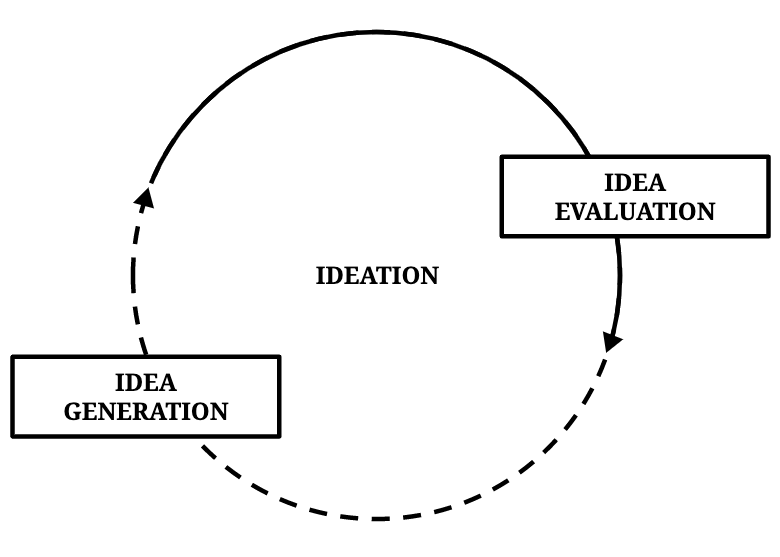Ideation is often thought to be mostly about idea generation. However, the process of developing ideas doesn’t stop there: it’s followed by an evaluation phase. Balancing idea generation with idea evaluation is crucial to the creative process.

“Within the field of creativity, idea generation in general and the usefulness of idea generation methods has received much greater attention than idea evaluation,” write Gerard Puccio and John Cabra in the Handbook of Organizational Creativity.
This lack of research may be due to the mysticism surrounding ideation. In Greek mythology, the muses served as intermediaries on behalf of the gods, who provided inspiration for creative ideas.
Today, we don’t quite believe in muses anymore, but we still look at ideas as this magical phenomenon which cannot be explained, and cannot be controlled. In the words of Carl Jung: “Any reaction to stimulus may be causally explained; but the creative act, which is the absolute antithesis of mere reaction, will forever elude human understanding. It can only be described in its manifestation; it can be obscurely sensed, but never wholly grasped.”
But our perception of the creative process doesn’t have to feel so obscure. While ideation is fascinating indeed, it’s not a black box we may never get to fully understand.
Ideation is an iterative process
Instead of a specific Eureka moment, researchers have identified two main elements in the ideation process, which involves the “generation of candidate ideas or solutions followed by extensive exploration of those ideas.”
- Idea generation. This phase of the creative process is about coming up with many blind variations to solve a problem. Quantity is the measure of performance.
- Idea evaluation. In this phase, selective retention is applied by assessing how practical, useful or relevant each idea is. The goal is to only keep quality ideas.
“Idea generation could be thought of as a search for novelty, while its process partner, idea evaluation, might be thought of as an effort to make novel thinking practical, useful or relevant.”
— Gerard Puccio and John Cabra.
Generating creative solutions is a complex cognitive process. Idea generation and idea evaluation rarely happen in a neat sequence. In fact, the iterative nature of ideation means we tend to alternate between the two phases.
Striking a balance
The creative process involves striking a balance between idea generation and idea evaluation. “The idea of a two-step process is now widely accepted,” says Arthur Cropley. “In my terms, this would involve novelty generation followed by (or accompanied by) exploration of the novelty from the point of view of workability, acceptability, or similar criteria to determine if it is effective. Only then would we speak of creativity.”
Idea generation is akin to divergent thinking, while idea evaluation is more similar to convergent thinking. First, we broaden the range of solutions, for instance by brainstorming, then we focus on the most relevant and applicable ones.
In order to make the most of these two modes of thinking, make sure to give as much weight to idea evaluation as you do to idea generation.
- Define your evaluation criteria. Before you start evaluating your ideas, consider what inclusion and exclusion criteria are relevant to your current project. An idea may be exciting but out-of-budget, or you may have some specific time constraints. List all of these factors so you have an objective way to assess your raw ideas.
- Get the data you need. Do not rely on intuition only to evaluate your ideas. Especially for complex problems, make sure to get all the information you need. Read the latest research, consult with experts, and seek advice from your colleagues.
- Consider using an evaluation framework. Beyond the pass-fail method, there are many evaluation frameworks you may find helpful in refining a range of ideas. A popular one is the Strengths, Weaknesses, Opportunities and Threats (SWOT) analysis, but you can create your own evaluation matrix.
- Allocate sufficient time for the evaluation process. Maybe brainstorming sessions dedicate 90% of the time to generating ideas, and rush at the end to choose a short selection to keep on exploring. Make sure you have enough time for the second phase of ideation.
- Follow up over the long term. The evaluation process should be continuous. Monitor the project to ensure the ideas you selected are providing the solution you expected. If that’s not the case, try to understand why: did the problem change? Was the idea not adequate in the first place? Document what you learn so it can be used for future projects.
Generating lots of ideas but failing to select the most appropriate ones is unlikely to result in positive creative outcomes. By making sure you value the evaluation process as much as the idea generation process, you are more likely to develop better creative ideas.
